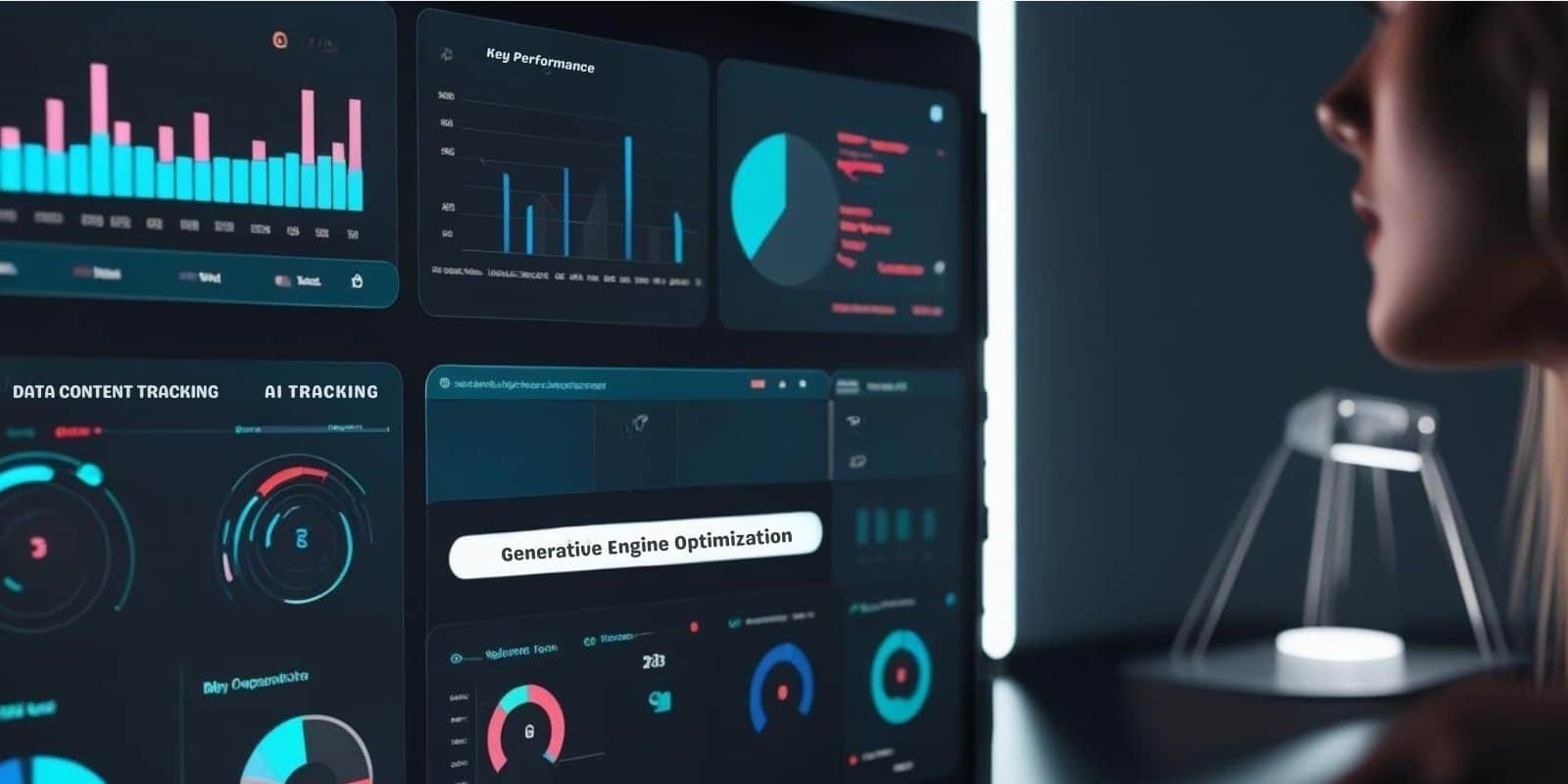Table of contents
Visibility in generative search systems such as ChatGPT, Perplexity or Google AI Overviews is a new success factor for brands and content managers. This led us to write this article “Measuring Generative Engine Optimization”. Traditional SEO KPIs such as rankings and CTR are no longer sufficient here; instead, mentions, source positions and AI relevance count. Measuring Generative Engine Optimization (GEO) is currently still a challenge, but there are initial tools, workarounds and methods. With targeted prompts, monitoring strategies and API approaches, important data can already be obtained today. Those who integrate GEO monitoring into their strategy now will secure a competitive advantage in the search landscape of tomorrow.
What does "Generative Engine Optimization measure" mean?
“Measuring generative engine optimization” means analyzing the visibility of brands, content or websites in generative responses – in other words, where AI-supported systems independently compile and reproduce content.
The aim is to:
- Identify mentions (i.e. mentions)
- Capture placements in AI-generated responses
- Understanding the influence on search behavior
GEO is fundamentally different from classic SEO, because:
There are no fixed rankings, no unique URL position and no standardized metrics – at least not yet.
How do classic SEO KPIs differ from GEO KPIs?
| Classic SEO | GEO (Generative Engine Optimization) |
| Organic ranking | Mentions / recommendation position in AI responses |
| Impresiones | Prompt-based visibility |
| CTR | Relevance in generated snippets |
| Indexing & Crawling | Access to training or caching sources |
| Keywords & meta data | Prompt relevance, semantic proximity |
GEO requires a rethink: visibility is generated dynamically – and depends on the prompt, the user’s intention and the model.
Why mentions count in ChatGPT, Perplexity & Co.
ChatGPT, Perplexity & Co. are changing user behavior. Instead of clicking through 10 blue links, users are increasingly relying on generative responses, often with specific recommendations.
If your brand is not mentioned there, you are invisible to many users.
Why this is important:
- ChatGPT is used as a research tool in many industries
- Perplexity shows specific sources – similar to featured snippets
- AI overviews are already influencing Google click behavior today
Example:
Question: “Which agencies in Germany offer Generative Engine Optimization?”
→ If the company does not appear here with its offer, it loses attention – regardless of the classic Google ranking.
Tracking Mentions in ChatGPT - How it Works
It is currently not possible to record all mentions in ChatGPT fully automatically – but there are practicable approaches.
Manual method
- Create a set of relevant prompts (e.g. “Top SEO agencies in Munich”, “Content consulting for SMEs”)
- Set the prompts regularly in ChatGPT
- Document the answers: Are you mentioned? Which competitors are mentioned?
Automation via API
- Use the OpenAI API to query prompts regularly
- Evaluate the results with scripts (e.g. Python + JSON parser)
- Attention: ChatGPT can “hallucinate” – validate the data
Tools (as at 22.08.2025):
- No Code: Notion + Zapier for recording
- Low Code: GPT Prompts via Airtable + API
- Custom: Python-Skripte with Scheduled Prompts

Perplexity monitoring for SEO - visibility in the answer engine
Perplexity offers you a unique opportunity for GEO measurement: It names specific sources that contributed to the answer.
What you can measure:
- Whether your domain is mentioned
- Where you appear in the response structure
- How often you show up for certain questions
Tools & Methods:
- Perplexity Pulse: Observe developments in AI answers
- GPTZero: Analysis of AI-generated content (indirectly useful)
- Own scraping: regularly query and evaluate search queries
Tip: Keep a list of questions where you want to be visible – and regularly check whether you are mentioned in the sources.
Be recognized in AI Overviews: How do you measure visibility on Google?
AI Overviews from Google are not yet available across the board – but they are coming. And they are changing the SERPs massively.
What you can measure:
- Is your URL displayed as a source?
- Which of your content appears in snippets?
- Are you named as a brand?
Tools (currently in development or beta):
- SGE Monitor from SEOClarity
- SE-Ranking can check whether your website and content are cited as a source
- Sistrix has an AI overview filter, among other things. This means that once you have entered your domain, you can use a filter to specifically filter for keywords for which Google displays an AI overview.
- Google SERP monitoring with extensions or custom scraping
If you appear in AI overviews, regularly document the formulations – they often come directly from your content.
New keyword filter: AI overview – with ranking
After entering a domain in the search bar, a filter is now available in the keyword table that can be used to filter specifically for keywords for which Google displays an AI overview.
Tools & methods for geo-measurement
| Tool / Methods | Function | Status |
| GPT Mention Tracker | Tracks mentions through API prompts | Manually |
| Perplexity Monitoring | Recognizes sources & placements | Active |
| Notion + Zapier | No-Code GEO Dashboard | Manually |
| Python-Skript (Custom) | Automated prompts via API | Advanced |
| Screencast + Prompting | Documentation of reactions | Basics |
Tip: Start with a simple Airtable or Google Sheet – write down your desired prompts, answers, date, placements & source.
Challenges & limits
Dynamic content
Answers vary by time of day, model version and prompt style.
Lack of standardization
There is no official “GEO metric” – everything is exploratory.
Need for interpretation
Just because you’re not mentioned doesn’t mean your content is bad – maybe just the prompt doesn’t fit.
Conclusion: GEO measurement as part of your strategy
The measurability of “Generative Engine Optimization” is still in its infancy – but those who start to deal with it now will become visible early on where others are still experimenting.
To-Dos for you:
- Define & track prompts
- Try out tools & methods
- Document mentions
- Optimize content specifically for prompt relevance
Start now with GEO measurement – and position yourself where tomorrow’s attention will be generated.
An interesting article for you:
⇒ GEO KPIs 2025: How to measure visibility in ChatGPT & Co.
⇒ To the Generative Engine Optimize Guide – last updated: August 22, 2025
Terms used in this article, simply explained:
⇒ What an API prompt is and what it is used for
FAQ: Frequently asked questions about: Measuring Generative Engine Optimization
→ Create targeted prompts in ChatGPT (“Which agencies offer X?”), or use automated prompt scripts.
Yes, e.g. Sistrix and SE Ranking or individual SERP snippets via browser extensions.
→ Observe whether your domain appears as a source. Tools such as Perplexity Pulse or GPTZero help with the analysis.
Step by step:
- Define relevant prompts
- Query answers regularly
- Document mentions & positions
- Set up tools (Notion, Airtable, Zapier)
- Optimize content based on the results
→ Yes, absolutely. Good content with E-E-A-T strengthens both classic SEO and GEO visibility.

Ready to measure your visibility in Ki search systems?
Let’s find out together how your Inhate performs in ChatGPT, Perplexity & Google AI Overviews – and how you can be at the top of your game.

People buy trust – not marketing speak.
Content marketing allows you to reach the heart and mind of your target group.
About the author:
My name is Isabel Unger, I am a freelance digital strategist with a clear focus: visibility for freelancers & small businesses. My heart beats for SEO, content, structure – and for explaining complex things in a way that makes them understandable and feasible.
On ixtreme.online I share my knowledge, my experience and a lot of plain language – without any technical gobbledygook.







